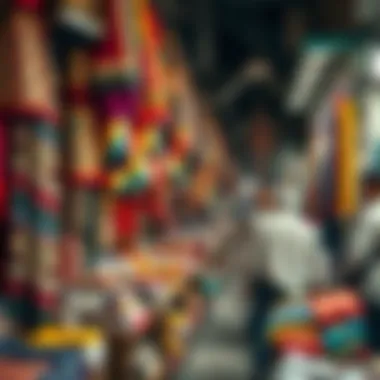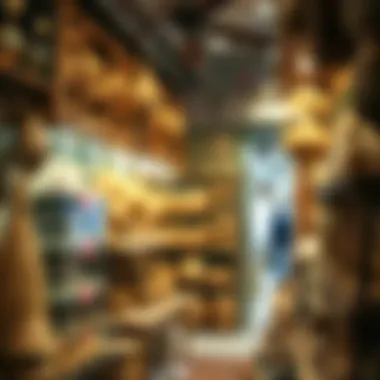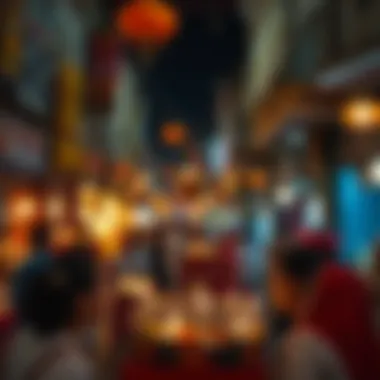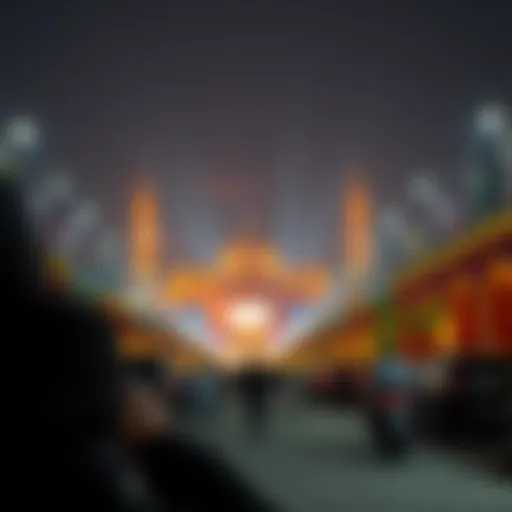Exploring Meena Bazaar: Accessibility via Dubai Metro


Intro
Meena Bazaar stands as one of Dubai’s most vibrant and lively districts, weaving together a rich tapestry of culture, commerce, and community. Nestled amidst the city's hustle and bustle, this market has established itself not only as a shopping destination but also as a reflection of the diverse heritage that Dubai embodies. Its proximity to the Dubai Metro has further enhanced its appeal, making it easily accessible for both locals and tourists alike.
Understanding the dynamics of Meena Bazaar goes beyond surface-level shopping; it delves into its historical significance and the economic impact it has wielded over the years. Visitors are often drawn to its eclectic mix of shops, which range from traditional garments to essential spices and intricate jewelry. Exploring this market allows one to connect with both the modern and traditional aspects of Dubai, showing how the past and present intertwine remarkably.
This guide aims to peel back the layers of Meena Bazaar, examining not just its accessibility but also the real estate trends surrounding the area. As the market flourishes, there arises a tantalizing opportunity for investors and homeowners to capitalize on the developments here. The following sections will elucidate on these aspects while providing valuable insights into what makes Meena Bazaar a hotspot worth considering.
Understanding Meena Bazaar
Meena Bazaar stands as more than just a marketplace; it embodies a tapestry of cultures interwoven through time in the heart of Dubai. This lively bazaar serves not only as a shopping destination but also as a cultural haven. Its significance stretches beyond the mere exchange of goods, touching on historical, social, and economic aspects that shape the broader narrative of Dubai. Understanding Meena Bazaar is crucial for anyone looking to grasp the intricate dynamics of the region, especially for investors and homebuyers seeking potential opportunities.
The market is a melange of flavors, sights, and sounds, providing a glimpse into the traditions that have thrived amidst the rapid modernization Dubai is known for. The bazaar is often a pivotal point of engagement for those interested in vibrant commerce and the amalgamation of cultures.
One cannot overlook how the proximity of Meena Bazaar to the Dubai Metro enhances its accessibility. The ease with which visitors can reach this hub has amplified its role as a cultural and economic engine, making it a straightforward choice for both locals and tourists. Let’s dissect this further.
Historical Background
Meena Bazaar has roots that stretch back several decades, originally serving the local Indian community. Initially, this area was characterized primarily by small, family-run shops and vendors selling traditional Indian goods, spices, textiles, and jewelry. Over the years, as Dubai began its ascent as a global city, the bazaar transformed significantly.
Noteworthy is how the historical context of this market interlinks with the evolution of the broader economic landscape in Dubai. Development across the region has redefined its boundaries and clientele. Many of the historical shops still exist, tempting nostalgia in long-time patrons, while modern establishments reinforce the bazaar's commitment to adapting without losing its identity.
Cultural Significance
Culturally, Meena Bazaar is a microcosm of Dubai's melting pot. It serves as a sanctuary for diverse communities, facilitating cultural exchanges that enrich the local atmosphere. Festivals and events often see vibrant celebrations here, showcasing traditional dance, cuisine, and art from various backgrounds.
The bazaar also plays a crucial role in preserving cultural heritage. It offers a platform for artisans and craftsmen to share their work, keeping age-old traditions alive amidst a rapidly evolving cityscape. This intermingling of old and new creates a unique ambiance where traditional values and modernity coexist harmoniously.
Commercial Landscape
Delving into the commercial landscape, Meena Bazaar emerges as a bustling marketplace driven by consumer demand and cultural appeals. Local entrepreneurs thrive here, offering goods that range from textiles to electronics, cooking spices to intricate jewelry. The variety ensures an eclectic shopping experience that’s hard to find elsewhere in Dubai.
The effects of Meena Bazaar on the local economy are profound. It attracts tourists, boosting not just individual shops but also nearby restaurants and services, feeding into the larger economic cycle. This commercial vitality leads to opportunities for investment and growth, making it an attractive spot for prospective buyers and entrepreneurs alike.
In summary, Meena Bazaar is not merely a shopping hub; it is a beacon of history, culture, and commerce that symbolizes Dubai's unique identity. Understanding its significance provides crucial insights into potential real estate and investment opportunities that can be harnessed in and around this vibrant marketplace.
Geographic Context
Understanding the geographic context of Meena Bazaar is crucial, as it reveals not just its physical location but also its cultural and commercial relevance in the landscape of Dubai. Situated near the heart of the city, this market has become an essential meeting point for both locals and tourists. Proximity to major transport links, like the Dubai Metro, amplifies its accessibility, enhancing the flow of visitors and fostering a vibrant marketplace.
Location Overview
Meena Bazaar is found in the district of Bur Dubai, an area steeped in historical significance. One can say it’s the beating heart of Dubai's traditional shopping scene. The market is flanked by the bustling streets filled with shops selling textiles, spices, jewelry, and an array of artifacts that reflect the rich heritage of the region. With Al Fahidi Metro Station just a stone's throw away, the area boasts excellent transport links, making it simple for naviagting this vibrant marketplace.
This prime location also makes it attractive for investors and businesses alike, fostering a thriving economy. Not only does the bazaar cater to daily shoppers and tourists, but it also attracts commercial interests looking to establish a presence in a location that pulls in foot traffic.
Landmarks and Attractions
When visiting Meena Bazaar, several landmarks and attractions nearby further enhance its appeal. Among the notables are:
- Dubai Museum: Located in the Al Fahidi Fort, this museum offers fascinating insights into the history of the emirate, encouraging a deep understanding of Dubai's evolution.
- Al Seef District: A waterfront destination that captures both modernity and tradition, showcasing restaurants and shops set against the backdrop of Dubai Creek.
- Sheikh Mohammed Centre for Cultural Understanding: A hub that promotes cultural exchanges; it offers programs aimed at educating visitors about the local customs, making it a worthwhile stop.
The synergy between Meena Bazaar and its landmarks ensures that visitors leave with a rich tapestry of experiences, blending shopping with culture.
This mix not only enhances Meena Bazaar’s significance as a shopping destination but also as a cultural hub. The attractions in proximity make it more accessible, as tourists can easily spend a day exploring the area.


In summary, the geographic context of Meena Bazaar serves as a significant factor contributing to its appeal. From the ease of access via the Dubai Metro to the multitude of attractions nearby, it becomes clear why this locale is considered a cornerstone of Dubai's commercial landscape.
Dubai Metro: A Gateway
The Dubai Metro serves not just as a public transport system but as a vital artery that enhances mobility and economic activity in the city. Its strategic design and operational efficiency make it an ideal means for residents and visitors to access key destinations, including Meena Bazaar. This bustling market stands out as a vibrant cultural and commercial hub, and the Metro plays a significant role in connecting people to it.
History of the Dubai Metro
The Dubai Metro was inaugurated in September 2009, marking a major milestone in the city’s transportation infrastructure. Initially, it consisted of the Red Line, which stretches from Rashidiya to Jebel Ali. The project was groundbreaking, representing a shift towards modern, sustainable public transport in a city defined by its rapid urban development. Over the years, the network expanded, incorporating the Green Line and several extensions that have improved accessibility.
A fascinating aspect of the Dubai Metro’s history lies in its ambitious goal: to reduce traffic congestion and offer an eco-friendly transport alternative. Spearheaded by the Roads and Transport Authority (RTA), the system quickly became known for its punctuality and cleanliness, earning the trust of users.
Route to Meena Bazaar
Reaching Meena Bazaar is a breeze via the Dubai Metro. The closest station is Al Fahidi, located on the Green Line. This station is situated within walking distance from the bazaar. Travelers can enjoy a leisurely stroll through the charming streets, soaking in the local architecture and atmosphere. The short distance allows passengers to avoid the hassle of parking and navigating through heavy traffic.
Some key points about the route include:
- Convenient transfers between the Red and Green Lines at Burjuman Station.
- Clear signage guiding passengers to the exit leading towards Meena Bazaar.
- A safe, air-conditioned environment that enhances the travel experience.
Convenience and Accessibility
The convenience of the Dubai Metro is unparalleled, particularly for those seeking to experience Meena Bazaar. With trains that run throughout the day at frequent intervals, waiting times are minimal. The automated system ensures consistency, which is especially vital for the bustling commerce of the bazaar.
Accessibility is designed with all users in mind. Ramps and elevators at the stations cater to individuals with disabilities, making the Metro a practical choice for everyone. Additionally, the affordability of the fares makes it an economical option for both locals and visitors. Not to mention, riding the Metro provides a unique perspective of Dubai’s stunning skyline, an experience unto itself.
"Dubai Metro is not just a mode of transport; it is a journey through the heart of the city, leading right to the vibrant pulse of Meena Bazaar."
Overall, the Dubai Metro stands as a critical component in shaping the economic and social landscape of the area around Meena Bazaar. Its role in fostering easy access contributes significantly to the market’s growth, attracting both tourists and locals alike, thereby solidifying its position as a must-visit destination in Dubai.
Economic Impact
The economic impact of Meena Bazaar is multifaceted, intertwining its cultural richness with substantial contributions to the local economy. This section underscores not only the vibrancy of this commercial hub but also how its accessibility through the Dubai Metro enhances its economic significance. The proximity of the Metro station serves as a catalyst for increased commerce, fostering a lively marketplace that attracts diverse crowds.
Influence on Local Businesses
Meena Bazaar teems with a variety of shops and businesses, many of which are family-owned or culturally significant. Their survival and growth often depend on the foot traffic that the Dubai Metro facilitates. By drawing locals and tourists alike, the Metro's convenience has turned Meena Bazaar into a go-to destination, boosting sales for retailers and service providers.
- Retail Diversity: From textiles to traditional Indian sweets, the bazaar showcases a patchwork of businesses catering to wide-ranging tastes and preferences.
- Economic Vitality: The constant stream of visitors invigorates the local economy, contributing to job creation and ensuring that small businesses continue to thrive.
- Community Development: Many shop owners have re-invested their earnings into the community, creating a ripple effect that promotes further economic development.
All these aspects weave a narrative of resilience and adaptability as local businesses harness this dynamic environment to grow and excel.
Tourism and Foot Traffic
Tourism forms an essential backbone of Meena Bazaar’s economy, largely thanks to its strategic location near key attractions and its easy access via the Metro. The increase in foot traffic not only benefits shop owners, but also enhances the overall visitor experience and encourages longer stays in the area.
- Visitor Attraction: Travelers seeking authentic cultural experiences often find Meena Bazaar in their itineraries, known for its vivid atmosphere and array of products.
- Length of Stays: With the Metro making access to Meena Bazaar hassle-free, visitors are likely to spend more time exploring its offerings, ultimately leading to increased spending.
- Tourism Partnerships: Many local businesses have started to collaborate with tourism agencies to create packages that highlight the bazaar, grabbing the attention of both domestic and international tourists.
"The integration of Meena Bazaar with the Dubai Metro isn't just about convenience; it’s about enriching the cultural tapestry and bolstering economic foundations that touch countless lives."
As can be seen, the interplay of local businesses and tourism makes Meena Bazaar more than just a shopping destination. It serves as a vibrant hub that fosters economic activity and cultural exchange, proving that accessibility is paramount in maximizing its potential.
Real Estate Implications
The dynamics of real estate in proximity to Meena Bazaar are crucial for investors, homebuyers, and developers. This area showcases vibrant economic activity and cultural richness, positioning it as a unique investment opportunity. The physical closeness to the Dubai Metro station amplifies this significance, enabling more straightforward access to the marketplace, thus attracting a mixed bag of residents and shoppers. Simply put, understanding the real estate implications is key when gauging future property values and market growth in this locality.


The neighborhood’s charm isn’t limited merely to its bazaar but extends to its residential and commercial infrastructure. The continuous influx of both local and international visitors spills over into the residential market. As businesses thrive, so does the demand for living spaces. Landlords and developers are increasingly keen to tap into this potential, particularly considering that Meena Bazaar’s accessibility via metro means residents can savor city life while being just a stone's throw away from daily conveniences.
"Real estate is not just about property; it’s about location, accessibility, and the lifestyle one is buying into."
Market Trends in Surrounding Areas
Examining the market trends around Meena Bazaar reveals a bustling real estate ecosystem marked by rapid growth and increasing interest. The residential sector has seen a noticeable uptick in demand, especially since the introduction of more metro stations. Properties in this vicinity are not only genuinely attractive but also merge affordability with accessibility.
Prices of both rental and purchased properties are nudged upward not just due to the locale’s historical heritage but because of the modernization that accompanies development—weaving tradition with contemporary living.
Key trends include:
- Rising rental prices: With the influx of residents seeking nearby accommodations, rental rates are gradually climbing, reflecting a deeper demand for housing.
- Diverse property types: From quaint apartments to spacious family homes, the diversity caters to varying demographic needs, thus broadening the buyer pool.
- Mixed-use developments: New constructions often combine residential, retail, and office spaces, creating vibrant ecosystems.
This approach not only influences lifestyle choices but also enhances property values over time. As the area continues to evolve, staying attuned to these market movements will guide prospective investors and buyers in making informed decisions.
Investment Opportunities
Investment prospects in the Meena Bazaar area are compelling for various reasons. First off, the ongoing urban development initiatives and improvements in transportation infrastructure underscore the potential for profit. Investors considering this area can capitalize on both residential and commercial markets.
Several investment opportunities stand out:
- Multifamily housing projects: The demand for rental spaces is on the rise, making investment in multifamily units a strategic move.
- Commercial establishments: Opening businesses in areas with high foot traffic like Meena Bazaar can yield substantial returns, especially given the regular influx of shoppers.
- Renovation projects: Older properties often hide significant value behind their fresh coats of paint. Investing in renovations can turn a profit when approached wisely, as modern amenities attract new renters and buyers alike.
- Real estate investment trusts (REITs): Investing through REITs centered around the UAE market can provide a way to engage with the real estate landscape without substantial capital investment up front.
Visitor Experience
The visitor experience in Meena Bazaar transcends a mere shopping trip; it is an immersion into the cultural tapestry of Dubai. With a wealth of shops and eateries, the bustling atmosphere of this market paints a vivid picture of the city’s diverse heritage. This section emphasizes various elements, benefits, and considerations for visitors, aiming to encapsulate the essence of this iconic destination.
Shopping Experience
Shopping at Meena Bazaar is often described as an adventure. Visitors are greeted not only by a plethora of shops but also by an array of scents and colors that beckon one to explore further. From traditional textiles to intricate jewelry, the authentic offerings here reflect the heart of South Asian culture.
Each shop has its own charm, making it easy to lose track of time as you browse items that seem to tell their own stories. Haggling is a common practice here, which adds to the thrill of shopping. It’s not just about acquiring a product; it’s about the experience of interaction with shopkeepers who often come from generations of artisans, showcasing their craft with pride.
- Unique Finds: Items such as handmade carpets, spices, and traditional garments can be found—like hidden treasures waiting to be discovered.
- Local Interaction: Engaging with vendors and locals establishes a connection that goes beyond mere transactions, fostering a deeper appreciation of their crafts.
Moreover, the accessibility of the bazaar through the Dubai Metro adds a layer of ease to the shopping experience, allowing visitors to seamlessly transition from one exciting adventure to another. It's typically bustling, and during peak shopping hours, the atmosphere can get quite vibrant, making it a lively spot for those eager to dive into city life.
Dining and Hospitality Options
After a long day of exploring the market, visitors can refuel at one of the many dining establishments in and around Meena Bazaar. The dining options here range from casual eateries to more upscale restaurants, each offering a taste of the local cuisine. You can find everything from savory curries to mouth-watering sweets.
- Street Food: Don’t miss out on street-side vendors selling delectable snacks like samosas and kebabs. These quick bites give a true sense of local flavor, both literally and figuratively.
- Authentic Restaurants: Several establishments offer full dining experiences, where guests can savor dishes that are made from recipes passed down through generations.
Additionally, the hospitality in these establishments often reflects the warm nature of the culture here. Visitors can expect attentive service, catering to their needs while allowing them to enjoy a laid-back meal amidst the hustle and bustle of the market.
As the sun sets, some of these hospitality venues offer ambience that complements the lively environment of Meena Bazaar, allowing one to wind down with a sweet chai or an authentic biryani, reflecting on the day’s adventures.
"To truly appreciate a place like Meena Bazaar, one must experience it through all senses, making it a remarkable stop for any visitor in Dubai."
In summary, the visitor experience at Meena Bazaar is more than just a destination; it’s a complete sensory engagement that combines shopping and dining, rich in interaction and cultural significance.
Future Developments
The topic of future developments surrounding Meena Bazaar is crucial in understanding the evolution of this area, particularly through the lens of continued urban growth and the progression of infrastructure. As Dubai continues to expand, investments in public transportation and urban planning are vital aspects to consider. Specifically, the impact of the Dubai Metro on the Meena Bazaar area highlights how accessibility can lead to economic opportunities, residential developments, and ultimately, a higher quality of life for its inhabitants. Future initiatives are designed not only to enhance accessibility but to promote a sustainable environment that accommodates the growing population and diversifies the local economy.


Urban Planning Initiatives
Urban planning initiatives in Dubai are built upon a foundation of strategic growth and sustainable development. To this end, Meena Bazaar stands to benefit significantly from planned enhancements in transportation and community infrastructure.
- Integration of Mixed-Use Developments: One initiative may involve promoting mixed-use developments that blend commercial, residential, and recreational spaces. This holistic approach can provide residents with everything needed within walking distance, making life easier and supporting local businesses.
- Green Spaces: Incorporating parks and green areas into the urban layout is also a focus. These spaces are essential for community engagement and can contribute to environmental quality. Initiatives to beautify public spaces may include tree planting and community gardens, which enhance the overall atmosphere of Meena Bazaar while inviting outdoor gatherings.
- Transportation Nodes: Future developments likely emphasize the importance of transportation nodes. The extension of the Dubai Metro and other public transportation options could further ease congestion and lead to an influx of visitors and residents alike, thus turning Meena Bazaar into a shopping and cultural hub.
Such initiatives ensure that Meena Bazaar keeps pace with Dubai’s rapid growth while maintaining the authenticity of its quirky charm and cultural significance.
Impact on Real Estate Market
The implications for the real estate market surrounding Meena Bazaar are substantial as urban planning and transportation improvements unfold. Investors, homebuyers, and developers need to be keenly aware of these factors.
- Increase in Property Values: With upgrades to infrastructure, property values are expected to rise. Increased accessibility typically attracts more buyers, leading to heightened demand for residential and commercial spaces. This uptick often translates into a robust investment opportunity.
- Diverse Residential Options: Future developments could signal a diversification in housing offerings. Developers may explore constructing apartments, villas, and affordable housing options, catering to the needs of various demographics, from families to expatriates.
- Commuter Appeal: Proximity to efficient transit options also makes properties in the area appealing to commuters. As more people look to minimize travel time to work or leisure, homes near the Dubai Metro become prime targets.
"Investors should keep an eye on Meena Bazaar as real estate developments progress alongside urban initiatives; opportunities abound in a flourishing economy."
- Collaborative Spaces: Lastly, with a focus on economic diversification, real estate projects may lean towards developing collaborative workspaces and co-living environments. Such spaces attract a modern workforce, fostering innovation and community in the heart of this vibrant bazaar.
Navigating Transportation
When discussing the experience of Meena Bazaar, one cannot overlook the significance of transportation. Meena Bazaar's appeal lies not only in its rich cultural essence but also in how easy it is to get there. Accessibility plays a crucial role in attracting visitors, whether they are locals or tourists. For investors and business owners, understanding transportation dynamics is essential for gauging foot traffic and commercial viability.
Multiple avenues of transportation converge at Meena Bazaar, making it a easily reachable hotspot in Dubai. This section will delve into the public transport options available and the parking facilities that support visitors' needs, enhancing the experience of everyone who ventures into this bustling marketplace.
Public Transport Options
The backbone of connectivity to Meena Bazaar is undoubtedly the Dubai Metro. Specifically, the Al Fahidi Metro Station stands as a gateway, positioned only a short walk from the bazaar. With efficient trains running at regular intervals, this option proves efficient, particularly during peak shopping hours. Trains whisk passengers from various points in the city, ensuring they can conveniently arrive and dive into the vibrant atmosphere without hassle.
Beyond the Metro, buses also service the area, covering routes that lead directly towards the bazaar. This kind of integration in public transport makes it enormously appealing, both for day-to-day shoppers and those visiting for special occasions. Local taxis and ride-sharing services further complement these options, offering last-minute flexibility for those who prefer a direct ride. All in all, the public transport setup ensures that Meena Bazaar is well linked to Dubai’s larger grid, making it a popular spot for commerce and culture alike.
Parking Facilities
For those who prefer to drive, parking availability remains another strong point for Meena Bazaar. The bazaar hosts several nearby parking facilities that cater to both short-term and long-term needs. Most facilities are equipped with modern amenities, including secure entry, lighting, and even surveillance cameras, thereby assuring visitors of their vehicle’s safety while they indulge in shopping.
Here’s what you need to consider:
- Cost: Parking is generally affordable, ensuring that visitors don't get hit in the wallet just for stopping by.
- Location: Many parking lots are conveniently located, thus minimizing the trek to the bazaar entrance.
- Capacity: It is worth noting that during weekends or special events, these lots may fill up quickly, so arriving earlier may be wise.
In summary, navigating transportation to Meena Bazaar combines the convenience of public transit and the accessibility of driving, making it an attractive destination and enhancing its allure for both casual visitors and serious shoppers. As urban planners and local government look towards the future, understanding these transportation dynamics will inform ongoing improvements and expansions in this vibrant area.
Culmination and Insights
The concluding section of this article on Meena Bazaar brings together various threads of discussion surrounding its cultural importance and economic vitality, underscoring the significance of accessibility via the Dubai Metro. As a vital component of Dubai's urban landscape, Meena Bazaar has evolved beyond just a marketplace; it has become a social nucleus fostering community bonds, cultural exchange, and entrepreneurial spirit. This chapter seeks to encapsulate the myriad insights gained throughout the article, highlighting the intersection of culture, commerce, and transportation that defines Meena Bazaar's role within Dubai.
Summary of Key Points
In this discourse, several critical points emerged:
- Cultural Significance: Meena Bazaar is more than a shopping destination; it symbolizes Dubai's rich cultural heritage and diversity, welcoming visitors from various backgrounds.
- Economic Impact: The bazaar plays a crucial role in driving local economies, offering a platform for small businesses and artisans, thereby contributing to Dubai's overall economic ecosystem.
- Transportation Accessibility: The Dubai Metro significantly enhances access to Meena Bazaar, making it easier for residents and tourists to explore its offerings, which in turn boosts foot traffic and commercial viability.
- Real Estate Implications: Proximity to such a vibrant hub can potentially influence property values, creating enticing opportunities for investors looking to capitalize on the area’s growth trajectory.
These factors collectively delineate why Meena Bazaar deserves attention not just as a market, but as a significant element in Dubai's socio-economic landscape.
Final Thoughts on Investment
Considering the wealth of information presented, the potential for investment surrounding Meena Bazaar is worth acknowledging. With the continuous urban development in Dubai, prospective investors should recognize that neighborhoods nearby, buoyed by accessibility to the Dubai Metro, are likely to experience a marked increase in property values.
Investors aiming for long-term growth may find properties within a reasonable distance to Meena Bazaar particularly appealing, given the cultural and economic vibrancy of the area. Furthermore, the ongoing emphasis on enhancing connectivity through various transportation options increases the desirability of these locations.
Investing near Meena Bazaar is not without its considerations, however. Stakeholders must stay updated on local policies and urban planning initiatives that could impact market dynamics. Nonetheless, the blend of cultural richness and economic opportunity makes Meena Bazaar a gold mine for savvy investors.
In sum, this exploration reveals that Meena Bazaar is more than just a traditional market; it stands at the crossroads of commerce and culture, making it a beacon for both locals and investors.















